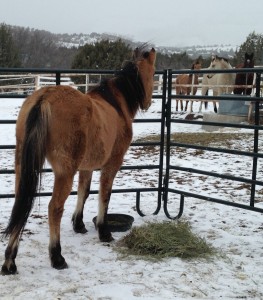In this installment of Mustang Miles & Minutes, Raechel Nelson continued to make progress with Alita and Zita. When 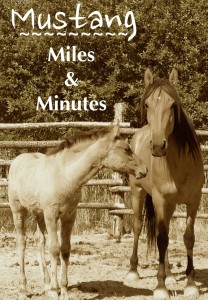 we talked with her, she’d successfully moved Alita out of her custom made roundpen and into a paneled enclosure where she could have closer contact with her future herd mates. It was the first time, the mare had been moved outside the roundpen since she was placed there untouched last summer from the BLM facility in Delta, Utah.
we talked with her, she’d successfully moved Alita out of her custom made roundpen and into a paneled enclosure where she could have closer contact with her future herd mates. It was the first time, the mare had been moved outside the roundpen since she was placed there untouched last summer from the BLM facility in Delta, Utah.
She’s taken some big steps after the momentous sessions with West Taylor.
What is Mustang Miles & Minutes?
Miles & Minutes is generously sponsored by Redmond Equine.
BestHorsePractices: Tell us about your progress since West’s visit.
Raechel Nelson: Because of my work schedule, it was a week later by the time I could spend training time with her. I got a rope around her nec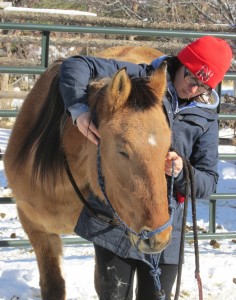 k and was able to lead her. But I didn’t get a halter on. She still recognized the concept of pressure and release. But it was still forty minutes until I could get hands on her. Now, after several weeks’ work, I can be successful within three minutes and get a halter on her.
k and was able to lead her. But I didn’t get a halter on. She still recognized the concept of pressure and release. But it was still forty minutes until I could get hands on her. Now, after several weeks’ work, I can be successful within three minutes and get a halter on her.
- We have continued working with haltering, getting her to back, move away from pressure with the hindquarters and the forehand.
- We’ve worked on desensitizing. I get hands-on everywhere, starting at shoulder, which is a safe spot, and working our way up the neck, down the face, down the legs, down the back and the hind quarters. I work on both sides. Repeat. Repeat. Repeat.
- Progressing forward from there, I’ve worked on picking up feet. Last week, I was able to get a trim on her front feet with nippers and a rasp.
- As far as desensitization, I was able to get a saddle pad on her and get a cinch around her, and get her so she would move comfortably with those on her back and around her girth. It was surprisingly anticlimactic.
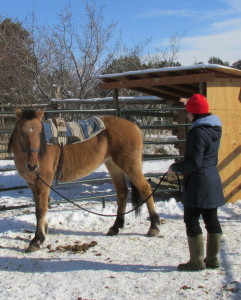 I had put a rope around her belly first, and got her used to that being tightened. Then, when I put a cinch around her, she was a little uncomfortable stepping forward at first, but otherwise gave no reaction.
I had put a rope around her belly first, and got her used to that being tightened. Then, when I put a cinch around her, she was a little uncomfortable stepping forward at first, but otherwise gave no reaction.
BHP: How’s her overall attitude?
RN: She’s still not willing to walk up and let you touch her. She’s not willing to initiate any contact. But once she has a halter on, she stays ground tied better than any horse I’ve ever had! Working with her feet, she’ll stay put. It’s almost like her demeanor changes once you catch her.
BHP: Do you think she stays ground tied so well because she’s afraid or resigned?
RN: Maybe a little bit of both. In working with her, I get the sense that there’s nowhere else she thinks she needs to be. There’s not a draw elsewhere. Maybe a domestic horse would say, ‘hey, there is grass over there.’ But I don’t think she has the confidence to debate that with you.
BHP: Describe the move from round pen to corral. You used panels to form a sort of chute into the trailer and then reset the panels to move her off the trailer. So, it was done without leading her. But the big difference from a similar scenario at the BLM facility months ago, was that Alita was calm. No panic whatsoever.
RN: Today was a good reminder for me. At first, I was in livestock mode which I remember from working cattle when I was young: “We got to get them into the trailer and momentum gets them onto the trailer. So, if I can run ‘em through the chute, they’re in. Slam the gate. Done.”
I didn’t think she had the capacity to learn within that situation. I didn’t think she was there yet. I thought we were just going to have to get it done and make it as nontraumatic as possible.
Listening to Steve (Peters) talk through it – using pressure on, pressure off – was good because it made me realize we can really learn in this situation . At this point, the trailer is not such an insurmountable object that she can’t calm down enough to learn. That was really good for me to understand that every experience can be a learning experience.
It was amazing watching her work through it. When she put her foot up on trailer, I released pressure [Nelson stood behind Alita, preventing her from returning from the round pen, and used a flag.]
She got it. She knew. She was really struggling with it because she really didn’t want to put her foot up there. Yet she was finding ways to keep her foot there longer because she knew the pressure would come back on when that foot came down. It was cool. She taught herself. All told, it took fifteen minutes.
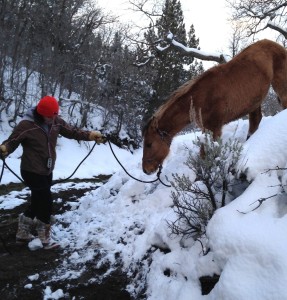 BHP: You’ve made significant progress with Zeeta, too. She’s been weaned and introduced to your gelding, Skeet, and mare, Maggie. What else have you done with the filly?
BHP: You’ve made significant progress with Zeeta, too. She’s been weaned and introduced to your gelding, Skeet, and mare, Maggie. What else have you done with the filly?
RN: I’ve been taking her out on the trail and introducing her to new things, building her confidence and while letting her be a baby. She picks up her feet for me, too.
I like to take her out on the trail: she gets to see new things, gets exercise and experiences with the dogs. At this point in her life, I don’t feel she needs education per say, just experiences. She knows what she needs to know for her age.

